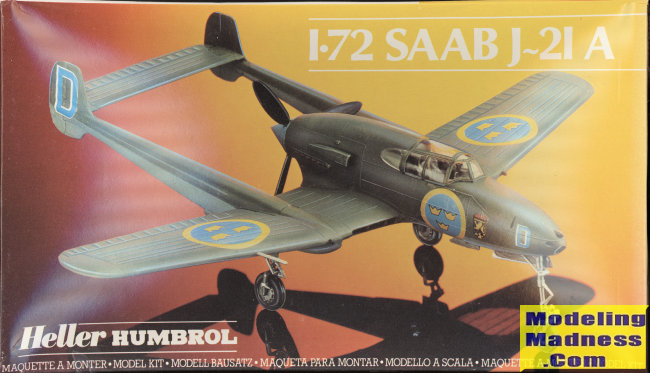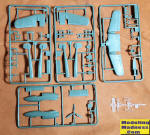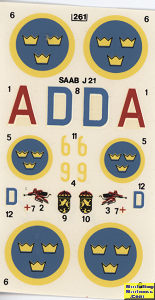
Heller 1/72 SAAB J.21A
| KIT #: | 80261 |
| PRICE: | $3.50 when new |
| DECALS: | Two options |
| REVIEWER: | Scott Van Aken |
| NOTES: | Original boxing |

| HISTORY |
The SAAB 21 is a Swedish single-seat low-wing monoplane fighter and attack aircraft designed and manufactured by SAAB. It used a twin boom fuselage with a pusher engine, giving the aircraft an unusual appearance.
Work began at SAAB following a Swedish Air Force decision to embark on a major expansion programme in preparation for the possibility of being drawn into the Second World War. The company designed a monoplane twin-boom aircraft, powered by a single Daimler-Benz DB 605B engine that was positioned to the rear of the fuselage nacelle, directly behind the pilot, and drove a pusher propeller. This arrangement allowed guns to be carried in the aircraft's nose while providing the pilot with good visibility. To enable the pilot to bail out without hitting the propeller behind him, they adopted an ejection seat.
On 30 July 1943, the 21 performed its maiden flight and on 1 December 1945, the first examples of the J 21A-1 were introduced to service. It was quickly followed by the improved J 21A-2, which featured heavier armament, and the A 21A-3 fighter-bomber. Due to Swedish Air Force interest in jet fighters, SAAB produced a conversion using the British de Havilland Goblin as the Saab 21R.
The 21 was replaced in the mid-1950s after less than 10 years of service by the similarly configured de Havilland Vampire and the Saab 29 Tunnan.
| THE KIT |
 Back
in the 1970s and early 1980s, I built a lot of Heller kits. This one, like the
others, is of a raised panel line tooling, though the detail is actually quite
good. This one has a few more parts than usual, contained on four brownish and
one clear sprue. The cockpit is fairlly well done with seat, stick, rear
bulkhead and instrument panel fitting on the floor that will later accept the
nose gear. This one will be a tail sitter so I'd recommend packing as much
weight forward of the main gear as you can.
Back
in the 1970s and early 1980s, I built a lot of Heller kits. This one, like the
others, is of a raised panel line tooling, though the detail is actually quite
good. This one has a few more parts than usual, contained on four brownish and
one clear sprue. The cockpit is fairlly well done with seat, stick, rear
bulkhead and instrument panel fitting on the floor that will later accept the
nose gear. This one will be a tail sitter so I'd recommend packing as much
weight forward of the main gear as you can.
Each of the booms will need to have the main gear legs installed prior to closing the boom halves. The cockpit will need to have the prop assembly build and installed when the fuselage halves are closed. It appears that the nose gear can be attached after painting, which is not the case for the main gear.
 When all
that is done, the fuselage is attached to the lower wing piece and the two upper
halves are then added. This is followed by the booms and the tailplane. Cockpit
clear bits are a single windscreen and two piece canopy/rear quarter windows.
This isn't molded as one piece to allow for the curved side windows to be
properly tooled.
When all
that is done, the fuselage is attached to the lower wing piece and the two upper
halves are then added. This is followed by the booms and the tailplane. Cockpit
clear bits are a single windscreen and two piece canopy/rear quarter windows.
This isn't molded as one piece to allow for the curved side windows to be
properly tooled.
Instructions are pretty basic but more than adequate, providing only Heller paint information. Markings are for two near identical aircraft the differ only by unit markings. Both planes are in dark olive (or black green) over aircraft blue. Decals are nicely printed and very matte. I'd suggest testing one that won't be used if you have an older boxing as you won't find aftermarket for this one.
| CONCLUSIONS |
One nice thing about Heller is that they were not afraid of tooling kits that others wouldn't touch. I'm not sure if there are any other 1/72 J.21s on the market, but this one will make for something a bit different on your shelves.
| REFERENCES |
https://en.wikipedia.org/wiki/SAAB_21
March 2024
Copyright ModelingMadness.com. All rights reserved. No
reproduction in part or in whole without express permission from the editor.
If you would like your product reviewed fairly and fairly quickly, please
contact
the editor or see other details in the
Note to
Contributors.